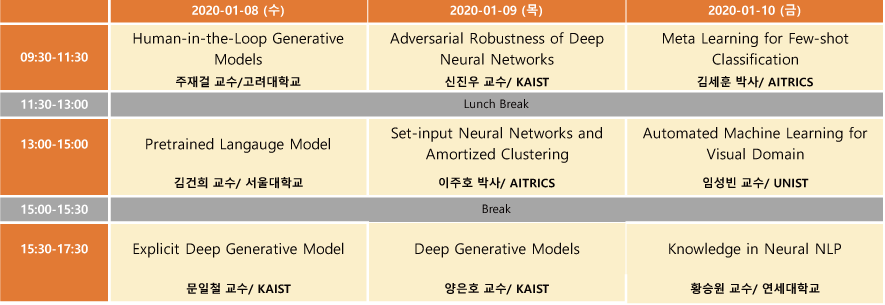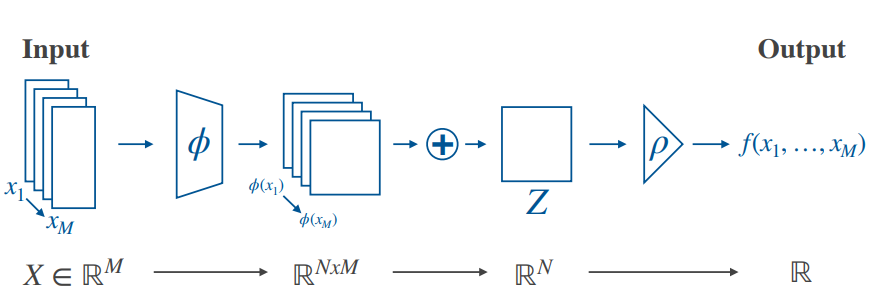2020 인공지능학회 동계강좌를 신청하여 2020.1.8 ~ 1.10 3일 동안 다녀왔다. 총 9분의 연사가 나오셨는데, 프로그램 일정은 다음과 같다.

전체를 묶어서 하나의 포스트로 작성하려고 했는데, 주제마다 내용이 꽤 많을거 같아, 한 강좌씩 시리즈로 묶어서 작성하게 되었다. 다섯 번째 포스트에서는 AITrics 이주호 박사님의 “Set-input Neural Networks and Amortized Clustering” 강연 내용을 다룬다.
- Introduction
- Common assumption
- Typical machine learning algorithms act on fixed dimensional data
- How about RNN ?
- Maybe variable-length, but in fixed-order (order matters)
- Repeated application of neural networks for fixed-length inputs
- Challenging tasks
- Point-cloud classification
- Multiple instance learning
- Few-shot image classification
- Set-input problems
- Inputs
- variable length
- order does not matter
- In other words, inputs are sets. X = \{ x_1, ..., x_n \}
- Today’s topic
- y = f(x;\theta)
- \theta* = arg min E_{p(x,y)}[L(f(x;\theta),y)]
- Inputs
- Common assumption
- DeepSets
- Permutation invariance and equivariance
- A function f: 2^x \rightarrow y is permutation invariant if
f(x_1, ..., x_n) = f(x_{\pi(1)}, ..., x_{\pi(n)}) - A function f: x^n \rightarrow y^n is permutation equivariant if
f(x_1, ..., x_n)=[f_1(x_1, ..., x_n), ..., f_n(x_1, ..., x_n)],
f(x_{\pi(1)}, ..., x_{\pi(n)})= [f_{\pi(1)}(x_1,..., x_n), ..., f_{\pi(n)}(x_1, ..., x_n)]
- A function f: 2^x \rightarrow y is permutation invariant if
- DeepSets
- Zaheer et al, Deep Sets, NIPS 2017
- Wagstaff et al, On the Limitations of Representing Functions on Sets, arXiv 2019

- \rho and \phi : any feedforward neural network
f(x) = \rho(\sum_{x \in X} \phi(x)) - Are DeepSets expressive enough?
- Let f:2^x \rightarrow y be a function on a countable x Then f is permutation invariant if and only if it is sum-decomposable [Zaheer et al, 2017]
- If x is uncountable, then there exists a function 2^x \rightarrow R which are not sum-decomposable [Wagstaff et al, 2019]
- Let f: R^{\leq n} \rightarrow R be a continuous function. Then f is permutation-invariant if and only if it is sum-decomposable with \phi(\cdot) \in R^n
- Examples for DeepSet-like architectures
- Prototypical networks
- Snell et al, Prototypical Networks for Few-shot Learning, NIPS 2017
- Neural statistician
- Edwards and Storkey, Towards a Neural Statistician, ICLR 2017
- Neural process
- Garnelo, Neural Processes, ICML 2018
- Can we learn everything from data, without assuming Gaussianity?
- Garnelo, Neural Processes, ICML 2018
- PointFlow
- Yang et al, PointFlow: 3D Point Cloud Generation with Continuous Normalizing Flows, ICCV 2019
- Prototypical networks
- Limitations of DeepSets
- Sum-decomposition does not take into account the interactions between elements in a set
- One can easily think of a problem that modeling interactions between elements is crucial
- Permutation invariance and equivariance
- Amortized clustering
- Clustering methods
- K-means clustering, spectral clustering, hierarchical clustering
- Soft K-means, Mixture of Gaussians
- Randomly initialize and iteratively refine cluster assignments
- Clustering with mixture of Gaussians
- Expectation-maximization (EM) algorithm to maximize the log-likelihood
- What if we have a batch of datasets to cluster?
- Clustering as a set-input problem
- Input : X = \{ x_1, ..., x_n \}
- Output : f(X) = (\pi, \mu, \sigma )
- Amortized inference in deep learning context
- Express some non-trivial inference procedures as neural network evaluations. Knowledge from previous inferences are distilled in parameters of the neural networks
- Old-school variational inference
- q(z|x) are optimized for each x_i
\prod^n_{i=1} q(z_i | x_i; \phi) = \prod^n_{i=1} N(x_i;\mu_i, \sigma^2_i)
- q(z|x) are optimized for each x_i
- Amortized variational inference
- q(z_i | x_i ; \phi) = N(z_i; \mu_{\phi}(x_i), \sigma^2_{\phi}(x_i))
- the inference procedure (approximating p(z_i | x_i;\theta) with q(z_i ; x_i;\phi) ) is expressed with the neural network evaluations ( \mu_{\phi}(\cdot), \sigma_{\phi}(\cdot))
- Amortized clustering
- Reuse the previous inference (clustering) results to accelerate the inference (clustering) of new dataset.
- Solving amortized clustering for mixture of Gaussians
- Build a permutation invariant f(\cdot;\phi) such as DeepSet architecture
- DeepSets does not work well
- Interaction between elements is crucial for clustering
- Clustering methods
- Set Transformer
- Attention mechanism
- Vaswani et al, Attention Is All You Need, NIPS 2017
- Dot-product attention mechanism
- Easy and efficient way to compute interactions between sets
O = Att(X,Y) = softmax(\dfrac{QK^T}{\sqrt{d}})V
- Easy and efficient way to compute interactions between sets
- Multihead QKV attention
- Concatenate multiple attention with different weights to get more robust results
- Self-attention
- Attending to itself
- efficiently encode pairwise interactions between elements in a set
- self-attention is permutation equivariant
- Set Transformer
- Lee et al, Set Transformer: A Framework for Attention-based Permutation-Invariant Neural Networks, ICML 2019
- Permutation invariant neural network based on self-attention
- Composed of a variant of transformer layer [Vaswani et al., 2017 ] that performs a permutation equivariant operation on sets
- Building blocks
- Multihead attention block (MAB)
- Self-attention block (SAB)
- Induced self-attention block (ISAB) : reduces time complexity to O(nm)
- Encoder
- roughly matches to \phi(x) in DeepSets, transforms elements in a set into features in a latent space
- Composed of a stack of ISABs
- Efficient computation due to inducing points
- Decoder
- Pooling by multihead attention (PMA) : instead of a simple sum/max/min aggregation, use multihead attention to aggregate features into a single vector
- Set input problems often require to produce multiple dependent outputs. (e.g. amortized clustering) In such case we utilize the self-attention mechanism in aggregation process
- Properties
- A Set transformer is at least as expressive as DeepSets, since it includes DeepSets as its special cases.

- Nothing known about universality (but can represent any set input functions that a DeepSet can represent )
- A Set transformer is at least as expressive as DeepSets, since it includes DeepSets as its special cases.
- Amortized clustering revisited
- Set transformer solves amortized clustering accurately

- Set transformer solves amortized clustering accurately
- Applications
- Unique character counting
- Anomaly Detection
- More complex clustering problems
- Lee et al, Deep Amortized Clustering, arXiv 2019
- Handling variable number of clusters
- Handling non-trivial cluster shapes
- Lee et al, Deep Amortized Clustering, arXiv 2019
- Attention mechanism